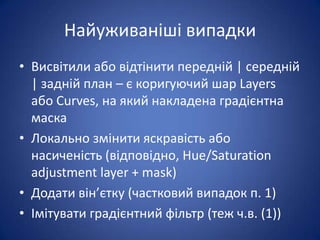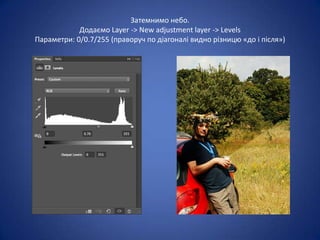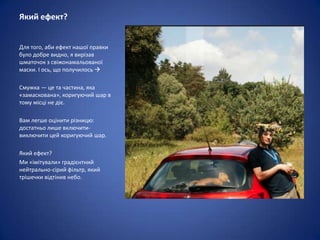Masks in Photoshop, level 0
- 1. ą£ą░čüą║ąĖ ą▓ Adobe Photoshop ąöčāąČąĄ ą┐čĆąŠčüčéąĖą╣ ąŠą┐ąĖčü
- 2. ą®ąŠ čéą░ą║ąĄ ą╝ą░čüą║ą░? ŌĆó ąĪą┐ąĄčåč¢ą░ą╗čīąĮąĖą╣ čłą░čĆ ąĘ čé.ąĘą▓. ą░ą╗čīčäą░-ą║ą░ąĮą░ą╗ąŠą╝, čÅą║ąĖą╣ ą╝č¢čüčéąĖčéčī č¢ąĮč乊čĆą╝ą░čåč¢čÄ ą┐čĆąŠ ą┐čĆąŠąĘąŠčĆč¢čüčéčī čłą░čĆčā, ąĮą░ čÅą║ąĖą╣ ąĮą░ą║ą╗ą░ą┤ąĄąĮą░ ą╝ą░čüą║ą░ ŌĆó ą¤čĆąŠąĘąŠčĆč¢čüčéčī ą║ąŠąČąĮąŠą│ąŠ ą┐č¢ą║čüąĄą╗čÅ ą╝ą░čüą║ąĖ čö č¢ąĮą┤ąĖą▓č¢ą┤čāą░ą╗čīąĮąŠčÄ ŌĆó ą¤ąŠ čüčāčéč¢, ą╝ą░čüą║ą░ ŌĆō čåąĄ čéą░ą║ąĖą╣ čüą░ą╝ąĖą╣ čłą░čĆ, čÅą║ č¢ č¢ąĮčłč¢, ą▓ čĆąĄąČąĖą╝č¢ ą▓č¢ą┤čéč¢ąĮą║č¢ą▓ čüč¢čĆąŠą│ąŠ, ą░ą╗ąĄ ąĮąĄą▓ąĖą┤ąĖą╝ąĖą╣.
- 3. ąØą░ą▓č¢čēąŠ čåąĄ č¢čüąĮčāčö? ąÉąæąś ą£ąś ą£ą×ąōąøąś ąÆą¢ąśąóąś ąøą×ąÜąÉąøą¼ąØąśąź ąÜą×ąĀąśąōąŻąÆąÉąØą¼
- 4. ąØą░ą╣čāąČąĖą▓ą░ąĮč¢čłč¢ ą▓ąĖą┐ą░ą┤ą║ąĖ ŌĆó ąÆąĖčüą▓č¢čéąĖą╗ąĖ ą░ą▒ąŠ ą▓č¢ą┤čéč¢ąĮąĖčéąĖ ą┐ąĄčĆąĄą┤ąĮč¢ą╣ | čüąĄčĆąĄą┤ąĮč¢ą╣ | ąĘą░ą┤ąĮč¢ą╣ ą┐ą╗ą░ąĮ ŌĆō čö ą║ąŠčĆąĖą│čāčÄčćąĖą╣ čłą░čĆ Layers ą░ą▒ąŠ Curves, ąĮą░ čÅą║ąĖą╣ ąĮą░ą║ą╗ą░ą┤ąĄąĮą░ ą│čĆą░ą┤č¢čöąĮčéąĮą░ ą╝ą░čüą║ą░ ŌĆó ąøąŠą║ą░ą╗čīąĮąŠ ąĘą╝č¢ąĮąĖčéąĖ čÅčüą║čĆą░ą▓č¢čüčéčī ą░ą▒ąŠ ąĮą░čüąĖč湥ąĮč¢čüčéčī (ą▓č¢ą┤ą┐ąŠą▓č¢ą┤ąĮąŠ, Hue/Saturation adjustment layer + mask) ŌĆó ąöąŠą┤ą░čéąĖ ą▓č¢ąĮŌĆÖčöčéą║čā (čćą░čüčéą║ąŠą▓ąĖą╣ ą▓ąĖą┐ą░ą┤ąŠą║ ą┐. 1) ŌĆó ąåą╝č¢čéčāą▓ą░čéąĖ ą│čĆą░ą┤č¢čöąĮčéąĮąĖą╣ čäč¢ą╗čīčéčĆ (č鹥ąČ čć.ą▓. (1))
- 6. ąŚą░č鹥ą╝ąĮąĖą╝ąŠ ąĮąĄą▒ąŠ. ąöąŠą┤ą░čöą╝ąŠ Layer -> New adjustment layer -> Levels ą¤ą░čĆą░ą╝ąĄčéčĆąĖ: 0/0.7/255 (ą┐čĆą░ą▓ąŠčĆčāčć ą┐ąŠ ą┤č¢ą░ą│ąŠąĮą░ą╗č¢ ą▓ąĖą┤ąĮąŠ čĆč¢ąĘąĮąĖčåčÄ ┬½ą┤ąŠ č¢ ą┐č¢čüą╗čÅ┬╗)
- 7. ą¤ąŠą┐ąĄčĆąĄą┤ąĮč¢ą╣ ą║čĆąŠą║ ą┤ąŠą▓ąŠą╗č¢ ąĘčĆąŠąĘčāą╝č¢ą╗ąĖą╣, ą░ čēąŠ ąČ čĆąŠą▒ąĖčéąĖ ą┤ą░ą╗č¢? ąöą░ą▓ą░ą╣č鹥 ąĘą╝č¢ąĮąĖą╝ąŠ ą╝ą░čüą║čā ą║ąŠčĆąĖą│čāčÄč湊ą│ąŠ čłą░čĆčā, ą░ą▒ąĖ ą▓č¢ąĮ ąĘą░čćč¢ą┐ą░ą▓ ą╗ąĖčłąĄ ąĮąĄą▒ąŠ. ąöą╗čÅ čåčīąŠą│ąŠ ą▓ąĖą▒ąĄčĆąĄą╝ąŠ ą▓ ą┐ą░ą╗č¢čéčĆč¢ čłą░čĆč¢ą▓ ą╝ą░čüą║čā ą┐ąŠčéčĆč¢ą▒ąĮąŠą│ąŠ ąĮą░ą╝ ą║ąŠčĆąĖą│čāčÄč湊ą│ąŠ čłą░čĆčā. ąćčŚ ąĘąĮą░č湊ą║ čĆąŠąĘčéą░čłąŠą▓ą░ąĮąĖą╣ ą▒č¢ą╗čÅ ąĘąĮą░čćą║ą░ ą║ąŠčĆąĖą│čāčÄč湊ą│ąŠ čłą░čĆčā č¢ ą╝č¢čüčéąĖčéčī ą╝č¢ąĮč¢ą░čéčÄčĆčā čüą░ą╝ąŠčŚ ą╝ą░čüą║ąĖ. ą®ąŠą╣ąĮąŠ ą╝ąĖ ą┤ąŠą┤ą░ą╗ąĖ ą╝ą░čüą║čā ŌĆö ą▓ąŠąĮą░ ą▒č¢ą╗ą░ (č鹊ą▒č鹊, ą┐ąŠą▓ąĮč¢čüčéčÄ ąĮą░ą║ą╗ą░ą┤ą░čöčéčīčüčÅ ąĮą░ ąŠą▒ŌĆÖčöą║čé, čēąŠ ą┐č¢ą┤ ąĮąĄčÄ). ąöą╗čÅ ą┐čĆąĖą║ą╗ą░ą┤čā ąĘ ą┐ąŠą┐ąĄčĆąĄą┤ąĮčīąŠą│ąŠ čüą╗ą░ą╣ą┤čā čÅ ąĘą░ą╝ą░ą╗čÄą▓ą░ą▓ ą┐ąŠą╗ąŠą▓ąĖąĮčā čåč¢čöčŚ ą╝ą░čüąŠčćą║ąĖ č湊čĆąĮąĖą╝ (č鹊ą▒č鹊, ąĄč乥ą║čé ą║ąŠčĆąĖą│čāčÄč湊ą│ąŠ čłą░čĆčā ąĮą░ ąĘąĮąĖą╝ą║čā ąĮąĄ ąĮą░ą║ą╗ą░ą┤ą░ą▓čüčÅ čéą░ą╝, ą┤ąĄ ą╝ą░čüą║ą░ ą▒čāą╗ą░ č湊čĆąĮą░). ąöąĖą▓ąĖą╝ąŠčüčī ąĘąĮąĖą╝ąŠą║ ąĄą║čĆą░ąĮčā:
- 8. ąóąĄą┐ąĄčĆ ŌĆō čéčĆąŠčłą║ąĖ ą╝ą░ą│č¢čŚ.ąØą░ą╝ą░ą╗čÄčöą╝ąŠ ąĮąŠą▓čā ą╝ą░čüą║čāą┤ą╗čÅ ą║ąŠčĆąĄą║čåč¢ą╣ąĮąŠą│ąŠ čłą░čĆčā. ąöą╗čÅ čåčīąŠą│ąŠ ą▓ąĖą▒ąĄčĆąĄą╝ąŠ č¢ąĮčüčéčĆčāą╝ąĄąĮčé ┬½ąōčĆą░ą┤č¢čöąĮčé┬╗ (G ąĘ ą║ą╗ą░ą▓č¢ą░čéčāčĆąĖ), čéą░ ą┐ąĄčĆąĄą▓č¢čĆąĖą╝ąŠ, ą░ą▒ąĖ ą║ąŠą╗čīąŠčĆąĖ ą╝ą░ą╗čÄą▓ą░ą╗ą║ąĖ čéą░ ą┐č¢ą┤ą╗ąŠąČą║ąĖ ą▒čāą╗ąĖ ą║ąŠą╗čīąŠčĆą░ą╝ąĖ ąĘą░ ąĘą░ą╝ąŠą▓čćčāą▓ą░ąĮąĮčÅą╝ (ą╝ą░ą╗čÄčöą╝ąŠ ą▒č¢ą╗ąĖą╝, ą┐č¢ą┤ą╗ąŠąČą║ą░ č湊čĆąĮą░). ą£ąŠąČąĮą░ ą┐čĆąŠčüč鹊 čéąĖą║ąĮčāčéąĖ D ąĮą░ ą║ą╗ą░ą▓č¢ą░čéčāčĆč¢ č¢ ą▓čüč¢ čüą┐čĆą░ą▓ąĖ. ąōčĆą░ą┤č¢čöąĮčé ą╝ą░ą╗čÄą▓ą░čéąĖą╝ąĄą╝ąŠ ą▓č¢ą┤ ą▒č¢ą╗ąŠą│ąŠ ą┤ąŠ č湊čĆąĮąŠą│ąŠ (ąĘą│ąŠčĆąĖ ą▓ąĮąĖąĘ), ą░ ą╣ąŠą│ąŠ ą┤č¢ą░ą┐ą░ąĘąŠąĮąŠą╝ ą▓č¢ąĘčīą╝ąĄą╝ąŠ ą║čĆąŠąĮčā ą┤ąĄčĆąĄą▓ą░, čēąŠ čüčéąĖčĆčćąĖčéčī ą▓ ą╗č¢ą▓č¢ą╣ čéčĆąĄčéąĖąĮč¢. ą¤čĆąĖčéąĖčüą║ą░čöą╝ąŠ Shift č¢ ą╝ą░ą╗čÄčöą╝ąŠ:ą▓č¢ą┤ č鹊čćą║ąĖ (1) ą┤ąŠ č鹊čćą║ąĖ (2). Shift ŌĆō ą░ą▒ąĖ ą▒čāą╗ąŠ č鹊čćąĮąŠ-č鹊čćąĮąŠ ą▓ąĄčĆčéąĖą║ą░ą╗čīąĮąŠ.
- 9. ą»ą║ąĖą╣ ąĄč乥ą║čé? ąöą╗čÅ č鹊ą│ąŠ, ą░ą▒ąĖ ąĄč乥ą║čé ąĮą░čłąŠčŚ ą┐čĆą░ą▓ą║ąĖ ą▒čāą╗ąŠ ą┤ąŠą▒čĆąĄ ą▓ąĖą┤ąĮąŠ, čÅ ą▓ąĖčĆč¢ąĘą░ą▓ čłą╝ą░č鹊č湊ą║ ąĘ čüą▓č¢ąČąŠąĮą░ą╝ą░ą╗čīąŠą▓ą░ąĮąŠčŚ ą╝ą░čüą║ąĖ. ąå ąŠčüčī, čēąŠ ą┐ąŠą╗čāčćąĖą╗ąŠčüčī ’āĀ ąĪą╝čāąČą║ą░ ŌĆö čåąĄ čéą░ čćą░čüčéąĖąĮą░, čÅą║ą░ ┬½ąĘą░ą╝ą░čüą║ąŠą▓ą░ąĮą░┬╗, ą║ąŠčĆąĖą│čāčÄčćąĖą╣ čłą░čĆ ą▓ č鹊ą╝čā ą╝č¢čüčåč¢ ąĮąĄ ą┤č¢čö. ąÆą░ą╝ ą╗ąĄą│čłąĄ ąŠčåč¢ąĮąĖčéąĖ čĆč¢ąĘąĮąĖčåčÄ: ą┤ąŠčüčéą░čéąĮčīąŠ ą╗ąĖčłąĄ ą▓ą║ą╗čÄčćąĖčéąĖ- ą▓ąĖą║ą╗čÄčćąĖčéąĖ čåąĄą╣ ą║ąŠčĆąĖą│čāčÄčćąĖą╣ čłą░čĆ. ą»ą║ąĖą╣ ąĄč乥ą║čé? ą£ąĖ ┬½č¢ą╝č¢čéčāą▓ą░ą╗ąĖ┬╗ ą│čĆą░ą┤č¢čöąĮčéąĮąĖą╣ ąĮąĄą╣čéčĆą░ą╗čīąĮąŠ-čüč¢čĆąĖą╣ čäč¢ą╗čīčéčĆ, čÅą║ąĖą╣ čéčĆč¢čłąĄčćą║ąĖ ą▓č¢ą┤čéč¢ąĮąĖą▓ ąĮąĄą▒ąŠ.
- 10. ą»ą║č¢ čēąĄ čö ą╝ąŠąČą╗ąĖą▓ąŠčüčéč¢? ŌĆó ąÆąĖą┤č¢ą╗ąĄąĮąĮčÅ ą┤ą╗čÅ ą╝ą░čüą║ąĖ ą╝ąŠąČąĮą░ ą┐čĆąŠčüč鹊 ąĮą░ą╝ą░ą╗čÄą▓ą░čéąĖ, ą▓ąĖą║ąŠčĆąĖčüč鹊ą▓čāčÄčćąĖ ą┐ąĄąĮąĘą╗čī (č¢ąĮčüčéčĆčāą╝ąĄąĮčé Brush) ŌĆó ąöą╗čÅ čüą║ą╗ą░ą┤ąĮąĖčģ ą╝ą░čüąŠą║, ą║ąŠą╗ąĖ čéčĆąĄą▒ą░ ą┐č¢ą┤čüąĖą╗ąĖčéąĖ, ą┐čĆąĖą┐čāčüčéąĖą╝ąŠ, ą╗ąĖčłąĄ čćą░čüčéąĖąĮčā ąĮąĄą▒ą░, ą╝ąŠąČąĮą░ ąĘą░ą▓ą░ąĮčéą░ąČąĖčéąĖ č¢ąĮč乊čĆą╝ą░čåč¢čÄ ąĘ ąŠą┤ąĮąŠą│ąŠ ąĘ ą║ąŠą╗čīąŠčĆąŠą▓ąĖčģ ą║ą░ąĮą░ą╗č¢ą▓ ąĘąŠą▒čĆą░ąČąĄąĮąĮčÅ
- 11. ą®ąŠ, ą▓čüąĄ? ąØą░ čüčīąŠą│ąŠą┤ąĮč¢ ŌĆö ą▓čüąĄ. ążą░ą╣ą╗ .psd, ąĮą░ą┤ čÅą║ąĖą╝ ą▓ąĖą║ąŠąĮčāą▓ą░ą╗ąĖčüčī ą┤ąŠčüą╗č¢ą┤ąĖ, ą╝ąŠąČąĮą░ ąĘą░ą▓ą░ąĮčéą░ąČąĖčéąĖ ąĘą▓č¢ą┤čüąĖ (5 ą£ą▒): http://alexnedoviziy.com/tmp/masks_1.psd
- 12. ąöą░ą╗č¢ ą▒čāą┤ąĄ? ą»ą║čēąŠ čåč¢ą║ą░ą▓ąŠ, č鹊 čÅ ą┐ąŠčüčéą░čĆą░čÄčüčī. mail@alexnedoviziy.com ąĪą░čłą░
Editor's Notes
- #12: ma












